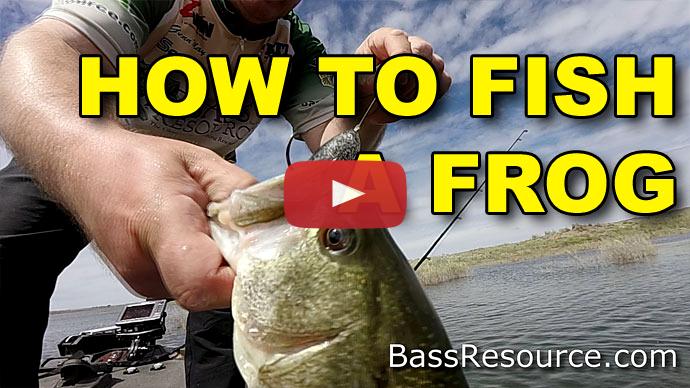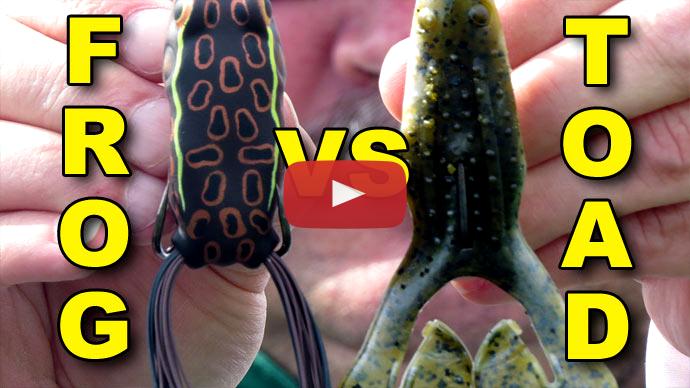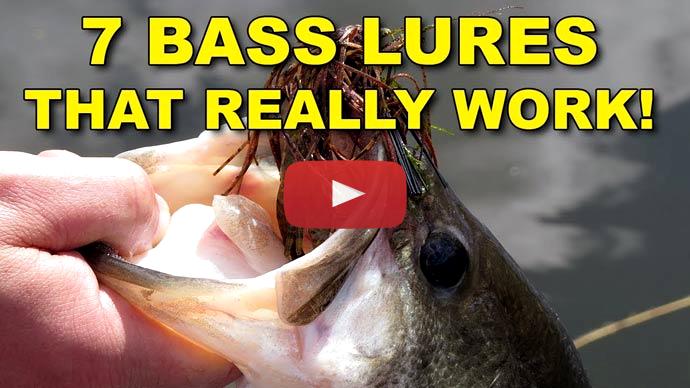Glenn: Really. Some bushes right here on the end of a flat that drop right off. Really, this is like a prime spot, and it was! Yes! There we go. Big old fish on a toad, on a toad! There we go. There we go. Come here. Right there. There we go. Oh, I think he wanted that. Look at that boys. Took that right down. That's what toad fishing can do for you right there. All right, buddy.
Hey folks. Glenn May here, with BassResource.com, and today I want to talk to you about toad fishing. Yeah, fishing solid body, soft plastic toads. These things are a blast to fish, especially in the warmer months. I love doing this. So today I want to talk to you a little bit about how to rig them up, what kind of gear you should be using, and then how to fish it. Let's first start off with equipment.
With toad fishing, you're going to be throwing in a lot of cover, a lot of places where the fish can wrap you up or around objects, be it bushes, trees, dock pilings, things like that, so you need some heavy duty gear. I'm using a heavy power, fast action rod. It's a seven foot three rod. You can use anywhere from say a 7.1 to a 7.8 rod, up to personal preference. I like rods a little bit on the shorter side of things, so I'm going with a 7.3. You need that heavy power and that backbone to set the hook and get that fish going towards you.
There's a huge hook you're going to be using. I'm going to show you. This is a thick 5/0 hook. I'll show you that in a second, and that's one of the reasons why you need a stout rod to set that hook. I'm using 50 pounds Kanzen braid line from Seagaur. The reason why I'm using that is, first of all, you're making long casts with toads. You're throwing it over big flats, areas of vegetation that may be just under the surface, and you're fan casting to it.
And what I mean by fan casting, is basically you start casting say about the 10:00 position, make your retrieve, the next cast is going to be about the 11:00 position, the next one at 12, 1, so on and so forth, okay? You're just covering, a very methodical way of covering a large expanse of water, but you're also making long casts to cover as much as you can.
So when you're using braided line, when you get above that 50 pound mark, it's kind of hard to cast long distances. It kind of inhibits your distance, so that's why I stick with 50 pound. I don't get any bigger than that. I specifically use Kanzen line, because toads, you know, they're very buoyant, they stay on the surface, but they do sink. The braided line helps. It's a little buoyant, and it helps them stay on the surface, rather than using say fluorocarbon, which can actually bring the bait down. Fluorocarbon is a little bit more dense and has a little more weight to it, so, you know, it doesn't float as much as braid, so that's why I'm using 50 pound Kanzen braided line.
On it, I'm using a reel that...the most important thing about the reel is not so much the reel speed, because you're not bringing the toad back at, you know, a mach 50 like you would crank baiting. What you want to focus on is the drag, and this is a Kastking Assassin Reel. It's got 16 and a half pounds of drag. That's pretty stout. Most production reels these days, when they come out, they usually have 11, 12 pounds of drag. This is 16 and a half, so you're getting up in that area where you have a really strong drag system. There are other reels that have that drag that strong, even some that have stronger drag than that. I'm not saying this is the only reel, but that's the choice you want to look at when you're looking for frog fishing, or toad fishing, what kind of drag that the reel has.
So let's talk about rigging here. Like I said, you're using a really stout hook. This is a 5/0, real thick wire hook, and it's keel weighted and also has a screw lock on it, all right? The key thing about the weight, see how far down the shank it is? That's what you want. You don't want it...there's some keel weighted hooks where I see the weight right up here. All's that's going to do is make your toad point downward, nose down. It's going to dig it into the water, and make it dive, so you want the weight further back here to where the hook starts the bend. This hook is by Moaner Hooks, but there's a lot of other hooks out there that have that kind of weight to it as well, weight placement, and then, of course, you got the screw locks.
So let me show you how you rig this. First of all, just with the screw lock, you put it right dead center, right in the nose of the frog or the toad here, and you just screw it on. I mean it's that straightforward. Just screw that on just like that. All right. Now it's on. Now, just like that, the key with fishing toads, you want that back to be straight or even have a little bit of a bow to it. That allows it to run true. If you've got it bowed like this, what's going to happen is that toad's going to want to flip over and run upside down, even though you've got this weight here, it's going to want to do that. This is a quarter ounce weight. You can go lighter than that. If you don't use a weight, the most...you're actually going to have problems with the toad spinning, especially if you bow it up like that. You've got to have a little bit of a bow down or perfectly flat. So I just rig it in like you would Texas style. You can see where the hook's supposed to come in. It's right in the very, very back, so I just push it up like that, put that hook right in the very back part of it, and there you go. Now I just skin hook it just barely, just like so. Nice and straight, see? All right. So that's how you rig it. Toads don't come with their own hook, so you've got to learn how to rig it right, but that's exactly what you want, nice, straight. See that, night and straight. Perfect, now we're ready to go toad fishing.
There. I had to wait until I felt em. There we go. There we go. There we go. Come here you. Look at that. Not a big guy, but he took it. See, the key with fishing these toads is when the fish blows up on it, your natural reaction is to set the hook right away. Instead, you gotta drop the rod, rod tip, and feed them slack, and feed it to them, and wait. Reel up some of that slack, wait until you feel the weight of the fish, and then pop em, you know. Drop the rod tip just a little bit, throw some slack along if you need to. Boom, and pop them in. Look, the hook went all the way through his cheek. That's how you do it guys.
The places where I like to fish it. I like to fish it in the areas where the weeds are just under the surface, from a few inches to maybe two feet or so under the surface. That's the perfect place to be throwing a toad. These little legs here they create some disturbance on the water, and a straight cast and retrieve works really, really well on a lot of toads. This is designed to be fished as slow as possible while keeping it on the surface, so, like I said, you don't need a fast reel for that. You just need to be able to reel it fast enough to keep it on the surface and create a little bubbling, gurgling action on the water.
Today, we don't have a lot of disturbance on the water. In other words, you don't have a lot of wind, so the slower the better. If there's a little more wind, you want to create a little more disturbance, so speed it up a little bit, and you create a little bit more of a gurgling action.
The unique characteristic about this Rage Toad, let me show you here, are its legs. You've got this little ridge right here, right, and that enables it, these legs, to move, and you're barely moving it across the water, right? It just doesn't take a whole lot of movement, so you can move it very, very slow and get a disturbance. But if the water is slick calm, and you're not, and it's just glass smooth, that's probably, even then, too much disturbance. So what you can do, is just take yourself, take a pair of scissors, and cut off the insides of this, right on the inside here, right here, just cut off a little bit of that meat right there, and make this leg, this part, thinner, and that will create less disturbance on the water. Real subtle action, especially when on those slick, calm mornings, just a little bit of gurgling, just keep shaving off a little bit of that, and you'll find you'll catch a lot, get a lot more bites.
Keri: There you go. Good one honey, good one, good one, good one, good one, good one.
Glenn: Here we go.
Keri: Nice fish.
Glenn: Here we go.
Keri: Nice one. Toad fishing at its finest.
Glenn: Come here. There we are.
Keri: Nice fish.
Glenn: So, the key, remember when you're fishing these toads, is to keep the rod tip up. Keep that rod tip up so you keep that toad toward the surface, and that what he did. He hit it right on the top.
Another thing to keep in mind is color. A lot of times what I like to do fish a bait that's got a little bit of green pumpkin in it and has a white belly. I think that looks the most natural and what most frogs look like, so I start with that. But if I'm not getting bites, or just getting blow-ups or follows, then I'll switch to a darker color, say a black, or I may go with a, like a camo type color, something that's got variations of different color, maybe a June Bug even, some kind of a darker color. And if all else fails, I'll try to find something really bright and obnoxious, like a chartreuse colored frog. You'd be surprised just by changing up color, how many more bites you'll get if your just getting follows or blow-ups.
A nice little hole right in there isn't it?
Keri: Oh. Nope.
Glenn: You've got to be kidding me.
Keri: I got a weed, but he blew-up on it. Throw in there. He didn't get it.
Glenn: Nope, doesn't want it.
[00:11:43]
[silence]
[00:12:14]
Keri: YUM Dinger time. He wanted it and look at that. If they don't hit the toad the first time, follow it up with a YUM Dinger.
Glenn: The thing with toads though is they don't work just in the spring. I'm sure you've been doing a lot a bit of research on this, and a lot of them say fish it in the spring, and then put them away. I don't know, I've been fishing toads. My wife and I have been fishing toads for decades now, and we didn't read any books on it. There wasn't YouTube out to learn how to fish it, so we just went out and started fishing them, and it turns out, we can be pretty successful with them any time the water is say about 55, 56 degrees, from the spring all the way to the fall, when it starts to cool down and pass that mark again, you can catch fish on a toad. So don't put it away in the spring. That'd be a mistake.
Throw it out in those flats where you see, you know, Milfoil, Hydrilla, Coontail, anything where it's just under the surface. Throw it out there, and make a nice, you know, easy cast, nice slow retrieve. Sometimes what we like to do is give it a little yank with a rod tip, and give it a little gurgle, and then slow it back down again, and don't be afraid to kill it. That little erratic action is often what triggers bites. So reel it, reel it, reel it, kill it, and then especially if you get it next to a bush, next to a dock piling, next to some kind of structure, that's a great place to kill it, and the fish will come up and smack it.
One other thing you need to be real careful about is when you're reeling these back in to the boat, and you're just about to pull it out of the water to make another cast, a lot of times that's when the fish smack it. It scares the bejesus out of you. I mean it's scared...they come up and just, you're just ready to pull it out of the water, and they come out and bam, smack it. I don't know why, but that's happened quite a bit with us fishing these toads, so be ready at any time and have a good pacemaker if you have those, because it can really stop your heart there for a second, but it's a real exciting way of fishing.
Keri: Whoa. Dear Lord.
Glenn: Whoa. Holy-Mollie.
Keri: Dear Lord.
Glenn: Wow.
Keri: That was like an instant. Holy crap. Right at the boat.
Glenn: Over on this side. Wow.
Keri: Right at the boat. Here you go, folks. I hope that was on camera.
Glenn: It was.
Keri: Because that was right at the boat. He just came up and ate that...
Glenn: Toad.
Keri: Toad. It just came up and ate that toad. There you go folks, toad fishing. It scared the daylights out of me.
Glenn: Anyway, that's basically the way you fish a toad. There's not a whole lot to it, other than just a nice steady retrieve, let it fall. If you're throwing it over the matted weeds, and there's like a pocket or something like that. You see a hole, let it drop down and tumble down in there and see if you can't get a bite and a lot of times that works.
Other than that, have a whole, heck of a lot of fun. I hope those tips help. For more tips and tricks, and for more answers to all your questions about bass fishing, visit BassResource.com.



